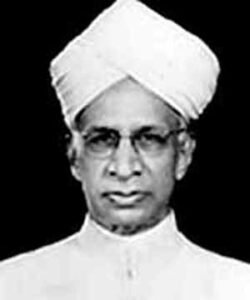
भारत के प्रथम उप-राष्ट्रपति और द्वितीय राष्ट्रपति डॉ० सर्वपल्ली राधाकृष्णन की जयंती के मौके पर हर साल शिक्षक दिवस मनाया जाता है. हमारे जीवन में शिक्षक का महत्वपूर्ण स्थान होता है. पौराणिक ग्रंथों में भी शिक्षकों के सम्मान से जुड़ी कई कहानियों का उल्लेख मिलता है. वैसे तो साल के 365 दिन शिक्षक के प्रति प्यार और सम्मान होता है लेकिन, 05 सितंबर का दिन कुछ ख़ास होता है. इस दिन आमतौर पर सांस्कृतिक कार्यक्रम का आयोजन कर कुछ अलग और ख़ास अंदाज में शिक्षक के प्रति सम्मान प्रकट किया जाता है.
डॉ० राधाकृष्णन का जन्म 05 सितम्बर 1888 को तमिलनाडु के तिरूतनी ग्राम के ब्राह्मण परिवार में हुआ था. बताते चलें कि, राधाकृष्णन का जन्म स्थान भी एक पवित्र तीर्थस्थल के रूप में विख्यात रहा है. राधाकृष्णन के पुरखे पहले कभी ‘सर्वपल्ली’ नामक ग्राम में रहते थे और 18वीं शताब्दी के मध्य में उन्होंने तिरूतनी ग्राम की ओर निष्क्रमण किया था. उनके पुरखे चाहते थे कि उनके नाम के साथ उनके जन्मस्थल के ग्राम का बोध भी सदैव रहना चाहिए.
डॉ० राधाकृष्णन के पिता का नाम ‘सर्वपल्ली वीरास्वामी’ और माता का नाम ‘सीताम्मा’ था. उनके पिता राजस्व विभाग में काम करते थे. राधाकृष्णन का बाल्यकाल तिरूतनी एवं तिरुपति जैसे धार्मिक स्थलों पर ही व्यतीत हुआ. उन्होंने जीवन के प्रथम आठ वर्ष तिरूतनी में ही गुजारे थे. उनके पिता पुराने विचारों के थे और उनमें धार्मिक भावनाएँ भी थीं, इसके बावजूद उन्होंने राधाकृष्णन को क्रिश्चियन मिशनरी संस्था लुथर्न मिशन स्कूल, तिरूपति के मध्य विद्याध्ययन के लिये भेजा. अगले चार वर्षों बाद उनकी शिक्षा वेल्लूर में हुई, उसके बाद उन्होंने मद्रास क्रिश्चियन कॉलेज, मद्रास में शिक्षा प्राप्त की. इन्होने 12 वर्षों के अध्ययन काल में राधाकृष्णन ने बाइबिल के महत्त्वपूर्ण अंश भी याद कर लिये. जिसके लिए उन्हें विशिष्ट योग्यता का सम्मान प्रदान किया गया.
वर्ष 1902 में मैट्रिक स्तर की परीक्षा उत्तीर्ण की और उन्हें छात्रवृत्ति भी प्राप्त हुई. इसके बाद उन्होंने वर्ष 1904 में कला संकाय परीक्षा प्रथम श्रेणी में उत्तीर्ण की. उन्हें मनोविज्ञान, इतिहास और गणित विषय में विशेष योग्यता की टिप्पणी भी उच्च प्राप्तांकों के कारण मिली. क्रिश्चियन कॉलेज, मद्रास ने उन्हें छात्रवृत्ति प्रदान की. दर्शनशास्त्र में एम०ए० करने के पश्चात् वर्ष 1916 में वे मद्रास रेजीडेंसी कॉलेज में दर्शनशास्त्र के सहायक प्राध्यापक नियुक्त हुए और बाद में उसी कॉलेज में वे प्राध्यापक भी रहे. बतातें चलें कि, डॉ० राधाकृष्णन अपने लेखों और भाषणों के माध्यम से विश्व को भारतीय दर्शन शास्त्र से परिचित कराया.
डॉ० राधाकृष्णन का विवाह 16 वर्ष की आयु में दूर के रिश्ते की बहन सिवाकामू से हुआ था. जब राधाकृष्णन का विवाह हुआ तो उनकी पत्नी की आयु मात्र 10 वर्ष थी और वो परम्परागत रूप से शिक्षा प्राप्त नहीं की थी, लेकिन उनका तेलुगु भाषा पर अच्छा अधिकार था साथ ही अंग्रेज़ी भाषा भी लिख-पढ़ सकती थीं. विवाह के 03 वर्षों बाद उनकी पत्नी ने उनके साथ रहना आरम्भ किया. वर्ष 1908 में राधाकृष्णन दम्पति को सन्तान के रूप में पुत्री की प्राप्ति हुई. उसी वर्ष उन्होंने कला स्नातक की उपाधि प्रथम श्रेणी में प्राप्त की और दर्शन शास्त्र में विशिष्ट योग्यता प्राप्त की. शादी के 06 वर्षों बाद उन्होंने कला में स्नातकोत्तर परीक्षा भी उत्तीर्ण कर ली. बताते चलें कि, उच्च अध्ययन के दौरान वह अपनी निजी आमदनी के लिये बच्चों को ट्यूशन पढ़ाने का काम भी करते रहे. वर्ष 1908 में उन्होंने एम० ए० की उपाधि प्राप्त करने के लिये एक शोध लेख भी लिखा उस वक्त उनकी उम्र मात्र 20 वर्ष की थी. उन्होंने वेदों और उपनिषदों का भी गहन अध्ययन किया साथ ही उन्होंने हिन्दी और संस्कृत भाषा का भी रुचिपूर्वक अध्ययन किया.
डॉ० राधाकृष्णन समूचे विश्व को एक विद्यालय मानते थे. उनका मानना था कि शिक्षा के द्वारा ही मानव मस्तिष्क का सदुपयोग किया जा सकता है. अत: विश्व को एक ही इकाई मानकर शिक्षा का प्रबन्धन करना चाहिए. ब्रिटेन के एडिनबरा विश्वविद्यालय में दिये अपने भाषण में डॉ॰ सर्वपल्ली राधाकृष्णन ने कहा था- “मानव को एक होना चाहिए. मानव इतिहास का संपूर्ण लक्ष्य मानव जाति की मुक्ति तभी सम्भव है जब देशों की नीतियों का आधार पूरे विश्व में शान्ति की स्थापना का प्रयत्न हो”. डॉ० राधाकृष्णन अपनी बुद्धि से परिपूर्ण व्याख्याओं, आनन्ददायी अभिव्यक्तियों और हल्की गुदगुदाने वाली कहानियों से छात्रों को मन्त्रमुग्ध कर देते थे साथ ही वो उच्च नैतिक मूल्यों को अपने आचरण में उतारने की प्रेरणा वह अपने छात्रों को भी देते थे. वर्ष 1912 में उन्होंने “मनोविज्ञान के आवश्यक तत्व” शीर्षक से एक लघु पुस्तिका भी प्रकाशित हुई जो कक्षा में दिये गये उनके व्याख्यानों का संग्रह था.
- वर्ष 1931 में ब्रिटिश साम्राज्य द्वारा “सर” की उपाधि प्रदान की गई.
- वर्ष 1931-36 तक आन्ध्र विश्वविद्यालय के वाइस चांसलर रहे.
- वर्ष 1946 में युनेस्को में भारतीय प्रतिनिधि के रूप में अपनी उपस्थिति दर्ज कराई.
- वर्ष 1936-52 तक ऑक्सफ़र्ड विश्वविद्यालय में प्राध्यापक रहे.
- वर्ष 1937-41 तक कलकत्ता विश्वविद्यालय के अन्तर्गत आने वाले जॉर्ज पंचम कॉलेज के प्रोफेसर के रूप में कार्य किया.
- वर्ष 1939-48 तक काशी हिन्दू विश्व्विद्यालय के चांसलर रहे.
- वर्ष 1953-62 तकदिल्ली विश्वूविद्यालय के चांसलर रहे.
- वर्ष 1947-49 तक संविधान निर्मात्री सभा का सदस्य रहें.
- वर्ष 1954 में स्वतन्त्र भारत के प्रथम राष्ट्रपति डॉ० राजेंद्र प्रसाद ने डॉ० राधाकृष्णन की दार्शनिक व शैक्षिक उपलब्धियों के लिये देश का सर्वोच्च अलंकरण भारत रत्न प्रदान किया.
डॉ. (प्रो.) जय राम झा,
संपादक.
============== ============ =============
Dr. Radhakrishanan A Philosopher and Teacher of Modern India.
 Teacher’s Day is celebrated every year on the occasion of the birth anniversary of Dr. Sarvepalli Radhakrishnan, the first Vice-President and second President of India. The teacher has an important place in our life. Many stories related to respect for teachers are also mentioned in mythological texts. Although there is love and respect for teachers 365 days a year, the day of 05 September is something special. On this day, cultural programs are usually organized to show respect to the teacher in a different and special way.
Teacher’s Day is celebrated every year on the occasion of the birth anniversary of Dr. Sarvepalli Radhakrishnan, the first Vice-President and second President of India. The teacher has an important place in our life. Many stories related to respect for teachers are also mentioned in mythological texts. Although there is love and respect for teachers 365 days a year, the day of 05 September is something special. On this day, cultural programs are usually organized to show respect to the teacher in a different and special way.
Dr. Radhakrishnan was born on 05 September 1888 in a Brahmin family in Tirutani village, Tamil Nadu. Let us tell you that the birthplace of Radhakrishnan has also been famous as a holy pilgrimage site. Radhakrishnan’s ancestors once lived in a village called ‘Sarvepalli’ and in the middle of the 18th century, they migrated to Tirutani village. His ancestors wanted that along with their name, the memory of the village of their birthplace should always remain there.
Dr. Radhakrishnan’s father’s name was ‘Sarvepalli Veeraswamy’ and his mother’s name was ‘Seetamma’. His father worked in the revenue department. Radhakrishnan’s childhood was spent in religious places like Tirutani and Tirupati. He spent the first eight years of his life in Tirutani. His father was old-fashioned and had religious sentiments, yet he sent Radhakrishnan to study at the Christian missionary institution Lutheran Mission School, Tirupati. For the next four years, he was educated in Vellore, after which he received his education at Madras Christian College, Madras. During his 12 years of study, Radhakrishnan also memorized important parts of the Bible. For which he was awarded the honor of special merit.
Passed the matriculation level examination in the year 1902 and also received a scholarship. After this, he passed the Arts Faculty examination in the first division in the year 1904. He also received a note of special merit in psychology, history, and mathematics due to his high marks. Christian College, Madras awarded him a scholarship. After doing her M.A. in Philosophy, in the year 1916, he was appointed Assistant Professor of Philosophy at Madras Residency College and later he also remained a professor in the same college. Let us tell you that Dr. Radhakrishnan introduced the world to Indian philosophy through his articles and speeches.
Dr. Radhakrishnan was married to Sivakamu, a distant cousin, at the age of 16. When Radhakrishnan got married, his wife was only 10 years old and had not received a traditional education, but she had a good command of the Telugu language and could also read and write in the English language. After 03 years of marriage, his wife started living with him. In the year 1908, the Radhakrishnan couple got a daughter as a child. In the same year, he obtained the degree of Bachelor of Arts in the first class and obtained distinction in philosophy. After 06 years of marriage, he also passed the post-graduate examination in arts. Let us say that, during higher studies, he also continued to do the work of teaching tuition to children for his personal income. In the year 1908, he also wrote a research article to obtain the title of M.A. At that time he was only 20 years old. He also studied Vedas and Upanishads deeply, as well as he studied Hindi and Sanskrit languages with interest.
Dr. Radhakrishnan considered the entire world as a school. He believed that the human brain can be put to good use only through education. Therefore, management of education should be done considering the world as a single unit. Dr. Sarvepalli Radhakrishnan said in his speech at the University of Edinburgh, UK – “Human beings should be united. The overall goal of human history is the salvation of mankind is possible only when the basis of the policies of the countries is the effort to establish peace in the whole world. Dr. Radhakrishnan used to mesmerize the students with his witty explanations, joyful expressions, and light tickling stories, as well as he used to inspire his students to imbibe high moral values in their conduct. In the year 1912, he also published a small booklet titled “Essential Elements of Psychology”, which was a collection of his lectures given in the classroom.
- In the year 1931, the title of “Sir” was conferred by the British Empire.
- The Vice Chancellor of Andhra University from 1931-36.
- In the year 1946, registered his presence as an Indian representative in UNESCO.
- A professor at Oxford University from 1936-52.
- Worked as a professor at George V College under Calcutta University from 1937-41.
- He was the Chancellor of Kashi Hindu University from 1939-48.
- The Chancellor of Delhi University from 1953-62.
- Be a member of the Constituent Assembly from 1947-49.
- In the year 1954, the first President of independent India, Dr. Rajendra Prasad, awarded the country’s highest decoration Bharat Ratna to Dr. Radhakrishnan for his philosophical and educational achievements.
Dr. (Prof.) Jai Ram Jha,
Editor.





